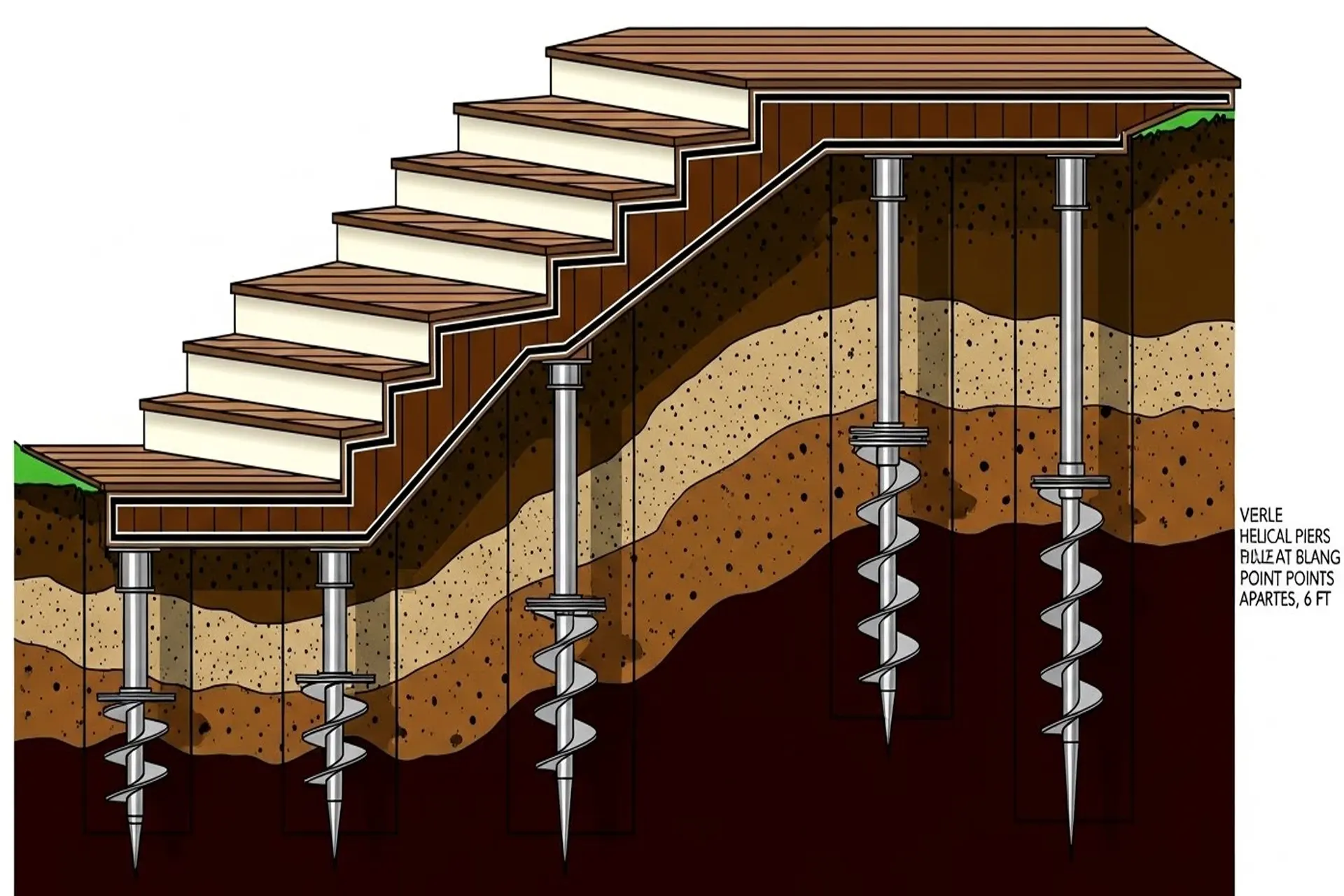Thinking of using helical piers for a deck, porch, or balcony in Long Island? You’re on the right track. Across Brooklyn, Queens, and the Bronx, we see the same problems year after year—sinking deck posts, unstable porches, rotted footings, erosion issues, and stair landings that start pulling away from the house. Most of these failures come down to one thing: weak or outdated deck foundations.
At Zavza Seal, we install them every week on real NYC homes, lifting sagging decks, stabilizing porches, and replacing failed concrete footings with foundations built for our soil, climate, and coastal conditions. If you’re here to learn more about installing helical piers for decks, you’re on the perfect page for that. If you’re planning a project here in Long Island, reach out to us for a free project assessment and detailed quote; we would love to help you get your project built for the future.
Get a Free Foundation Assessment for Your Deck or Porch Today!

Benefits of Helical Piers for Decks, Porches, and Balconies
Helical piers for decks, porches, and balconies offer superior stability, especially on unstable soil, coastal properties, and flood-zone environments. Their deep, screw-in design anchors below weak or shifting layers, preventing settlement, rot, and erosion-related failure while providing immediate structural support.
Key Benefits:
- Anchors Below Weak Soil: Reaches stable layers deep underground to prevent sinking and long-term settlement issues.
- Ideal for Flood Zones: Performs reliably in high water tables where concrete footings often fail or shift.
- Stronger in Coastal Conditions: Resists erosion, moisture, and salt exposure common on Long Island and NYC shorelines.
- No Frost-Heave Movement: Eliminates lifting and shifting caused by winter freeze–thaw cycles in New York climates.
- Immediate Structural Support: Installed with instant load capacity, allowing deck or porch construction the same day.
Schedule Your Helical Pier Consultation Today!
Pier Types for Residential Decks & Balconies
Now that we’ve established why helical piers outperform traditional footings in NYC soil, here’s a look at the specific pier types used for different deck and porch configurations.
- Light-Duty Residential Piers: Designed for standard backyard decks and small porches needing reliable, everyday support.
- Standard Brackets for Beams/Girders: Provides strong load transfer for primary beams and structural girders.
- Adjustable Porch Brackets: Allows precise leveling for porches that may experience minor movement over time.
Pier Materials & Connection Hardware
New York’s soil conditions change from block to block. Dense urban fill in the Bronx, sandy coastal ground across Long Island, expansive clay pockets in Queens, and wet, erosion-prone soil in Brooklyn. Because of this, the materials and hardware used in your helical pier system are just as important as the pier itself. The right combination ensures long-term stability, corrosion resistance, and code-compliant structural support for any deck, porch, or balcony.
- Galvanized Steel: Built to resist corrosion and moisture, making it ideal for wet soil, drainage issues, and older NYC properties with high humidity.
- Special Coastal Coatings: Adds an extra layer of protection against salt, erosion, and shoreline weather, critical for homes near bays, canals, and waterfronts across Long Island.
- Beam Brackets: Transfers deck loads directly into the pier for maximum stability and long-term structural performance.
- Porch Ledger Supports: Strengthens the connection between porch framing and the home’s structure, reducing movement and preventing pull-away.
- Stair Landing Anchors: Keeps stair systems level, safe, and secure, especially important for properties with shifting soil or uneven ground.
When Each Type Is Used
Now that the components are clear, here’s how these materials and hardware combinations apply to real NYC deck and porch projects.
- Elevated Back Decks: Ideal for uneven yards or areas with poor soil compaction.
- Front Porches: Perfect for older homes where shallow concrete footings have settled or deteriorated.
- Multi-Level Decks: Provides strong, adjustable support for complex tiered structures.
- Cantilevered Balconies: Prevents sagging, rotation, and long-term deflection in extended balcony designs.
- Decks Near Water / Sandy Soil: A top choice for Long Island homes exposed to erosion, high water tables, and storm-driven soil movement.
How Helical Piers Are Installed & How Load Capacity Is Determined
Helical pier installation isn’t guesswork, it’s a measured engineering process that ensures your deck, porch, or balcony is supported by deep, load-bearing soil. Here’s how professionals determine exactly how much weight each pier can safely carry.
Pre-Construction Measurements for Installation
Before the first pier goes into the ground, we evaluate the site to determine the correct depth, spacing, and load requirements.
- Soil Testing: Identifies soft pockets, water saturation, and the type of ground we’ll be anchoring into.
- Load Calculations: Determines how much weight your deck or porch will exert on each pier.
- Depth Requirements (NYC Frost Line ~42″): Ensures piers extend below freeze–thaw zones to prevent movement.
- Torque-to-Capacity Correlation: Installation torque readings confirm precisely when a pier reaches stable bearing soil.
Helical Piers Installation Process
Once measurements are complete, installation is fast, clean, and highly controlled.
- Pier Installed via Hydraulic Drive Head: The pier is twisted deep into the ground until torque confirms proper load capacity.
- Torque Verified for Structural Support: We measure resistance to confirm the pier can support its designated load.
- Brackets Attached: Beam, porch, or stair brackets are locked in for immediate stability.
- Framing Begins Same Day: No concrete curing, construction continues immediately.
Case Study: Chimney Repair and Stainless Steel Liner Installation in Brooklyn, NY
A homeowner in Brooklyn, NY contacted Zavza Seal after discovering water leaking through their chimney and into the home. Our inspection revealed that the original flashing around Chimney #1 had been improperly installed and had deteriorated, allowing water to seep behind the structure and damage the skin coat. The chimney needed a full waterproofing rebuild and a safe, code-compliant venting system.
Our team installed 15 feet of new aluminum flashing, restored the chimney exterior with wire mesh and two coats of stucco, and built a custom frame to integrate the stucco into the adjoining wall. A new cement crown was added for long-term protection. To address the heating system, we installed 45 feet of a 6-inch stainless steel liner designed to vent both the hot water heater and gas appliance, complete with a top plate, tee, and rain cap. The liner includes a lifetime manufacturer warranty.
The result was a fully repaired, leak-free, and safe chimney ready for long-term performance.
Why Choose Zavza Seal for Helical Piers for Decks in Long Island
Choosing the right contractor matters just as much as choosing the right foundation system. Zavza Seal brings structural expertise, coastal soil experience, and a proven track record across Long Island, Brooklyn, Queens, and the Bronx. Our team delivers precise installations backed by real field knowledge and long-term reliability.
Key Advantages:
- Licensed And Insured
- Five-Year Workmanship Warranty
- Coastal Soil And Flood-Zone Experience
- ICC-Compliant Installations
- Fast, Clean, One-Day Installation
- Structural And Waterproofing Expertise
- Local Long Island Technicians
- Proven Track Record With NYC Deck Foundations
- Torque-Verified Load Capacity
- Residential And Multi-Level Deck Capabilities
Get a Free Project Assessment for Helical Piers for Decks in Long Island
Whether you are choosing helical piers for decks to rebuild a failing deck foundation, stabilize a porch, or you’re planning new construction, Zavza Seal provides accurate measurements, clear recommendations, and fast turnaround. Our team evaluates soil conditions, load requirements, and project goals to ensure your deck or porch is built on a foundation that lasts.
Get a Free Deck Foundation Assessment Today!
Frequently Asked Questions About Helical Piers for Decks in Long Island and NYC
How long do helical piers last?
Helical piers typically last 50 to 100 years because they are made from corrosion-resistant steel and protected with specialty coatings.
Can helical piers be used for porch repairs?
Yes, helical piers are commonly used to stabilize sagging or shifting porches by transferring weight to deeper, stronger soil.
Are helical piers allowed by NYC building code?
Yes, helical piers meet ICC-ES standards and are approved for residential deck and porch foundations throughout New York City.
How deep do helical piers go?
Most helical piers reach depths of 6 to 20 feet, depending on torque readings and the soil’s load-bearing strength.
Are helical piers better than concrete for decks?
Helical piers perform better than concrete in NYC because they resist frost heave, moisture, and movement in soft or fill-based soil.
Can helical piers be installed in tight Brooklyn backyards?
Yes, installation equipment is compact and can fit through narrow walkways, alleyways, and small side gates.
Can helical piers support multi-level or heavy decks?
Yes, helical piers often support between 2,000 and 5,000 pounds per pier, making them suitable for large, multi-level decks.
Do helical piers work in sandy or coastal soil?
Yes, helical piers perform extremely well near water because they bypass loose sand and anchor into stable soil layers.
Can helical piers be installed during winter?
Yes, helical piers can be installed year-round because they do not rely on concrete curing or temperature-sensitive materials.
How long does helical pier installation take?
Most installations are completed in one day, and the deck or porch framing can begin immediately after the piers are set.








